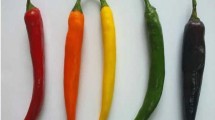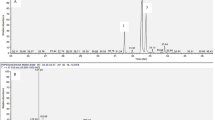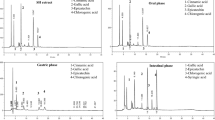Abstract
Chilli peppers have been recognized as an excellent source of antioxidants as they are rich in bioactive phytochemicals such as carotenoids which are known to exert various beneficial effects in vivo. Absorption is an important factor in the determination of the potential biological effects of carotenoids. The bioaccessibility of a food constituent such as a carotenoid represents its potential to be absorbed in humans. There is very limited information in the literature regarding the content and bioaccessibility of carotenoids from dried peppers. Therefore, the objectives of the present study were: first, to determine the carotenoid content of 20 varieties of red, orange or yellow coloured sun-dried chilli peppers belonging to either of four Capsicum species (annuum, baccatum, chinense and chacoense); and second, to quantify the carotenoid micellarization (bioaccessibility) following an in vitro digestion procedure. Red peppers had a higher carotenoid content and bioaccessibility than either the orange peppers or yellow pepper. Xanthophylls showed greater bioaccessibility than carotenes. Our findings confirm that dried chilli peppers are a good source of carotenoids.
Similar content being viewed by others
Abbreviations
- DW:
-
Dried weight
- HBSS:
-
Hank’s balanced salts solution
- SEM:
-
Standard error of the mean
References
Chenlo F, Chaguri L, Santos F, Moreira R (2006) Osmotic dehydration/impregnation kinetics of padrón pepper (Capsicum annuum L. Longum) with sodium chloride solutions: process modelling and colour analysis. Food Sci Technol Int 12:221–227
Camera B, Monéger R (1978) Free and esterified carotenoids in green and red fruits of Capsicum annuum. Phytochemistry 17:91–93
Howard LR (2001) Antioxidant vitamin and phytochemical content of fresh and processed pepper fruit (Capsicum annuum). In: Wildman RC (ed) Handbook of nutraceuticals and functional foods. CRC Press, Boca Raton, pp 209–233
Guzman I, Hamby S, Romero J, Bosland PW, O’Connell MA (2010) Variability of carotenoid biosynthesis in orange colored Capsicum spp. Plant Sci 179:49–59
Govindarajan VS (1986) Capsicum–production, technology, chemistry, and quality. Part III. Chemistry of the color, aroma, and pungency stimuli. Crit Rev Food Sci Nutr 24:245–355
Hernández-Ortega M, Ortiz-Moreno A, Hernández-Navarro MD, Chamorro-Cevallos G, Dorantes-Alvarez L, Necoechea-Mondragón H (2012) Antioxidant, antinociceptive, and anti-inflammatory effects of carotenoids extracted from dried pepper (Capsicum annuum L.). J Biomed Biotechnol 2012:524019
Hervert-Hernández D, Sáyago-Ayerdi SG, Goñi I (2010) Bioactive compounds of four hot pepper varieties (Capsicum annuum L.), antioxidant capacity, and intestinal bioaccessibility. J Agric Food Chem 58:3399–3406
Kaur C, Kapoor HC (2001) Antioxidants in fruits and vegetables – the millennium’s health. Int J Food Sci Technol 36:703–725
Hoffman PG, Lego MC, Galetto WG (1983) Separation and quantitation of red pepper major heat principles by reverse phase high-pressure liquid chromatography. J Agric Food Chem 31:1326–1330
Krinsky NI (2001) Carotenoids as antioxidants. Nutrition 17:815–817
Stahl W, van den Berg H, Arthur J et al (2002) Bioavailability and metabolism. Mol Aspects Med 23:39–100
Tyssandier V, Reboul E, Dumas JF, Bouteloup-Demange C, Armand M, Marcand J, Sallas M, Borel P (2003) Processing of vegetable-borne carotenoids in the human stomach and duodenum. Am J Physiol Gastrointest Liver Physiol 284:913–923. doi:10.1152/ajpgi.00410.2002
Garrett D, Failla M, Sarama R (1999) Development of an in vitro digestion method to assess carotenoid bioavailability from meals. J Agric Food Chem 47:4301–4309
O’Sullivan L, Ryan L, Aherne SA, O’Brien NM (2008) Cellular transport of lutein is greater from uncooked rather than cooked spinach irrespective of whether it is fresh, frozen, or canned. Nutr Res 28:532–538
Victoria-Campos CI, Ornelas-Paz J d J, Yahia EM, Failla ML (2013) Effect of the interaction of heat-processing style and fat type on the micellarization of lipid-soluble pigments from green and red pungent peppers (Capsicum annuum). J Agric Food Chem 61:3642–3653
O’Sullivan L, Galvin K, Jiwan MA, Aherne SA, O’Brien NM (2008) Content and bioaccessibility of carotenoids from green vegetables is not affected by saponification. In: Proceedings of the 38th Annual Conference on Food, Nutrition and Consumer Sciences (September 11, 2008). University College Cork, Ireland
Taylor KL, Brackenbridge AE, Vivier MA, Oberhoster A (2006) High-performance liquid chromatography profiling of the major carotenoids in Arabidopsis thaliana leaf tissue. J Chromatogr A 1121:83–91
Baker R, Günther C (2004) The role of carotenoids in consumer choice and the likely benefits from their inclusion into products for human consumption. Trends Food Sci Technol 15:484–488
Krinsky NI, Mayne ST, Sies H (2004) Carotenoids in health and disease. Marcel Dekker, New York
Palmero P, Lemmens L, Ribas-Agustí A, Sosa C, Met K, de Dieu UJ, Hendrickx M, Van Loey A (2013) Novel targeted approach to better understand how natural structural barriers govern carotenoid in vitro bioaccessibility in vegetable-based systems. Food Chem 141:2036–2043
Troconis-Torres IG, Rojas-López M, Hernández-Rodríguez C, Villa-Tanaca L, Maldonado-Mendoza IE, Dorantes-Álvarez L, Tellez-Medina D, Jaramillo-Flores ME (2012) Biochemical and molecular analysis of some commercial samples of chilli peppers from Mexico. J Biomed Biotechnol 2012:873090
Aherne SA, Jiwan MA, Daly T, O’Brien NM (2009) Geographical location has greater impact on carotenoid content and bioaccessibility from tomatoes than variety. Plant Foods Hum Nutr 4:250–256
Guil-Guerrero JL, Martinez-Guirado C, del Mar R-FM, Carrique-Perez A (2006) Nutrient composition and antioxidant activity of 10 pepper (Capsicum annuum) varieties. Eur Food Res Technol 224:1–9
Garcia MI, Lozano M, de Espinosa VM, Ayuso MC, Bernalte MJ, Vidal-Aragon MC, Perez MM (2007) Agronomic characteristics and carotenoid content of five Bola-type paprika red pepper (Capsicum annuum L.) cultivars. Sci Hortic 113:202–207
Minguez-Mosquera MI, Hornero-Mendez D (1993) Separation and quantification of the carotenoid pigments in red peppers (Capsicum annuum L.), paprika and oleoresin by reversed-phase HPLC. J Agric Food Chem 41:1616–1620
Tundis R, Loizzo MR, Menichini F, Bonesi M, Conforti F, De Luca D, Menichini F (2012) Air-dried Capsicum annuum var. Acuminatum medium and big: determination of bioactive constituents, antioxidant activity and carbohydrate-hydrolyzing enzymes inhibition. Food Res Int 45:170–176
Tundis R, Loizzo MR, Menichini F, Bonesi M, Conforti F, Statti G, De Luca D, de Cindio B, Menichini F (2011) Comparative study on the chemical composition, antioxidant properties and hypoglycaemic activities of two Capsicum annuum L. cultivars (acuminatum small and cerasiferum). Plant Foods Hum Nutr 66:261–269
Almela L, López-Roca JM, Candela ME, Alcázar MD (1991) Carotenoid composition of new cultivars of red pepper for paprika. J Agric Food Chem 39:1606–1609
Pérez-Gálvez A, Martin Hans D, Sies H, Stahl W (2003) Incorporation of carotenoids from paprika oleoresin into human chylomicrons. Br J Nutr 89:787–793
Breithaupt DE, Bamedi A, Wirt U (2002) Carotenol fatty acid esters: easy substrates for digestive enzymes? Comp Biochem Physiol B 132:721–728
Rich GT, Faulks RM, Wickham MS, Fillery-Travis A (2003) Solubilisation of carotenoids from carrot juice and spinach in lipid phases: II. Modelling the duodenal environment. Lipids 38:947–956
van Het Hof KH, West CE, Weststrate JA, Hautvast JG (2000) Dietary factors that affect the bioavailability of carotenoids. J Nutr 130:503–506
O’Sullivan L, Jiwan M, Daly T, O’Brien NM (2010) Bioaccessibility, uptake, and transport of carotenoids from peppers (Capsicum spp.) using the coupled in vitro digestion and human intestinal Caco-2 cell model. J Agric Food Chem 58:5374–5379
Ha SH, Kim JB, Park JS, Lee SW, Ch KJ (2007) A comparison of the carotenoid accumulation in Capsicum varieties that show different ripening colours: deletion of the capsanthin-capsorubin synthase gene is not a prerequisite for the formation of a yellow pepper. J Exp Bot 58:3135–3314
Acknowledgments
This work was supported by European Community POR (Programmi Operativi Regionali) Calabria FSE (Fondo Sociale Europeo) 2007/2013. The authors are grateful to Miceli s.r.l. (Italy) for supplying the pepper fruits.
Conflict of Interest
The authors declare that they have not conflict of interest.
Author information
Authors and Affiliations
Corresponding author
Rights and permissions
About this article
Cite this article
Pugliese, A., O’Callaghan, Y., Tundis, R. et al. In vitro Assessment of the Bioaccessibility of Carotenoids from Sun-Dried Chilli Peppers. Plant Foods Hum Nutr 69, 8–17 (2014). https://doi.org/10.1007/s11130-013-0397-2
Published:
Issue Date:
DOI: https://doi.org/10.1007/s11130-013-0397-2




